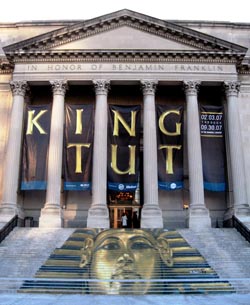|
When designing this study, NLTeC took an uncommon approach by holding facilitated discussions with the Franklin Institute marketing team. This feedback from staff provided NLTeC with a rare insight many studies fail to incorporate. Not only did this input serve as an important tool for the study’s design, but it also helped identify important issues necessary to evaluating the exhibit’s overall success.
“The [marketing] team’s main priority was to strongly emphasize learning and to engage the tourist in a meaningful way,” Fesenmaier said. The Franklin Institute asked NLTeC to find the main predictors that create a positive, mindful experience for tourists.
“We discussed various characteristics of the market and discovered the importance of not only tangible attributes, but also intangible attributes, in predicting a tourist’s experience,” Racherla said. “Without this facilitated discussion, we might have never discovered this.”
Building on the concept that tangible and intangible attributes are of equal importance, the survey asked respondents to think back to the multisensory aspects of the exhibit. Most vivid to the respondents were colors, such as variations of gold and blue; smells, such as sandalwood and musk; and sounds, such as musical instruments, chimes and Egyptian music. Eighty-eight percent of respondents said the music set the mood.
Although this painted a detailed picture of the visitor’s experience, the researchers were surprised to find that the predictors of a positive, mindful experience were not unique to the King Tut exhibit.
“Surprisingly, none of the variables revolved around the King Tut exhibit,” Fesenmaier said. “We actually found seven generic variables that measure visitor engagement to serve as the best predictors in creating a mindful experience.” (See sidebar.)
When predicting how well an exhibit will create this positive experience, these seven variables provide a statistical measurement.
“In this case, 80 percent of respondents felt they had learned from the exhibit,” Newmuis said, “while 85 percent evaluated the overall experience as good, excellent or superior. This finding not only proves that the King Tut exhibit was a great success, but that learning is an important predictor in a visitor’s enjoyment of his or her overall experience.”
For the Franklin Institute, these generic variables will serve as a mental checklist for future displays, which will ensure every exhibit will fully engage visitors.
"We are excited to incorporate the findings of this study as a way to further enhance the visitor experience,” said Franklin Institute CEO Dennis M. Wint, who was awarded the Greater Philadelphia Hotel Association’s 2007 Heart of Philadelphia award for bringing the King Tut exhibit to the city. “As Philadelphia's reputation continues to grow, we hope that our new and improved exhibits at the Franklin Institute will continue to be one of Philly's main attractions."
Ninety-two percent of the exhibit’s groundbreaking number of visitors reported that their experience proved Philadelphia to be a cultural, creative destination.
“These variables revealed that the true measure of an exhibit’s success are intangibles that show how much the exhibit can captivate visitors,” Fesenmaier said.
“A successful exhibit will make visitors feel like they’ve stepped into another world, engage their mind with exciting new facts, and absorb their attention to the point that they lose track of time.”
Visitors should:
• Feel they have learned
• Be engaged by the layout
• Have their attention highly focused
• Have their interest fully captured
• Feel like they are in a different world
• Become highly absorbed in the exhibit
• Lose track of time
— Written by Margaret Mastrogiacomo
for the School of Tourism and Hospitality Management
|
